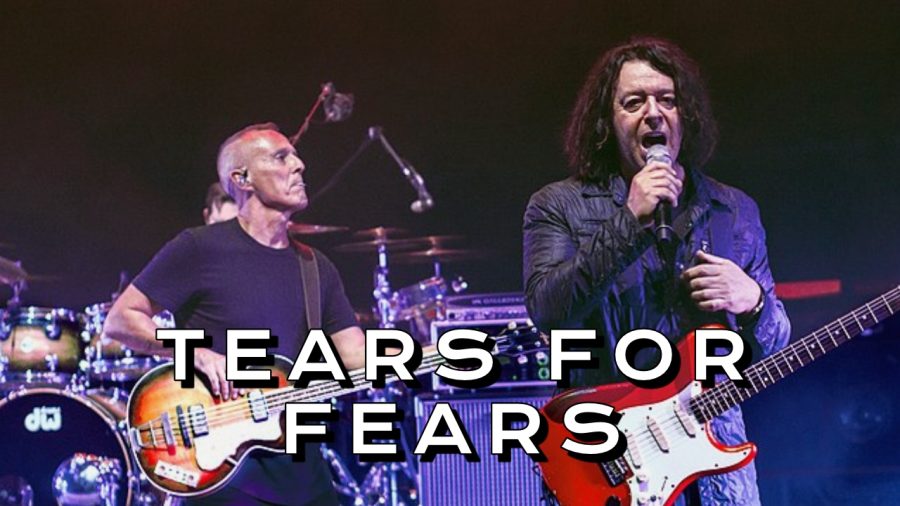With Tears for Fears’ New Album, Closure after Loss is Resolved
Abigail Gallup/ Wikipedia Commons
Tears for Fears- A Rating by Kyle Miner
March 30, 2022
In the mid-1980s, the core duo of Tears for Fears were white-hot not only in their native UK but more so in the United States. Their opus, Songs from the Big Chair, was the number-one album for five weeks here in 1985, as well as spawning three top-5 singles, two of which went to number one. Four years later, they unleashed The Seeds of Love onto the world, and while it was just as mighty overseas, it seemed to have moderate success here in the USA. Still, don’t let that fool you with the sound of the actual tracks, which makes sense considering at that point it was the most expensive album ever produced.
During the 1990s, the duo of Curt Smith and Roland Orzabal had a bit of fallout and during the 9-year period they were apart, Roland released two albums under the TFF name, while Curt had a bit of a mediocre-at-best solo career. Thankfully, the two made up at the turn of the century, recording an album for 2004, Everybody Loves a Happy Ending. Unfortunately, during that time, some other factors kept them from recording for the last almost 18 years, even if they still tour regularly.
Fast-forward to today – the duo has finally released their newest album, The Tipping Point, through the Concord label. And was all that waiting worth it? Well, I’d certainly say so.

The album in itself had a bit of a troubled production as well. The original idea was for the duo to pair up with today’s contemporary songwriters, but those plans were scrapped after a while of doing that. As a de-facto Plan B, the two sat down on the couch and wrote some new songs with acoustic guitars; a few of these songs made the cut on the final tracklisting. As for the songs themselves? Well, let me just say that they are as introspective as they may seem, especially taking into consideration that most of them were inspired by the death of Roland’s wife, Caroline, from alcohol-related dementia in 2017.
The opening cut, No Small Thing, has the tinges of aging to it, looking back on life and to the future, and just having fun in life without the insecurities of the little things. The song afterward, The Title Cut, was the first single released when the album was announced in October 2021. I would best describe it as a slow burn, with a minute-long intro that builds into the main melody. The lyrics reflect on life’s tipping point, AKA the transition from earthside to heaven, in saying that you will never know when the transition will happen until it’s too late.
Long, Long, Long Time follows, which is a very light psychedelic pop tune with Curt on vocals and the chorus is rather ethereal in itself, due to being relegated to one of the female backing vocalists. Break the Man comes afterward, and if someone were to tell me that this was one of the scrapped tracks from the contemporary songwriter’s sessions, I would believe you, it definitely has a very commercial sound to it. Ending Side 1, we have My Demons, which is an extremely stark change-of-pace to the album’s sound, having more of a Depeche Mode darkwave vibe than anything else, and I absolutely love it.
Starting the second half of the album is Rivers of Mercy, which brings another change to the album’s sound, as compared to the song before it, this one is very somber. In a sense, this song especially hits hard, due to the Russo-Ukraine invasion, and the first verse is definitely topical for the moment: Well, the streets have started burning, there’s trouble in the towns – I guess the devil loves his playground, that’s for sure. But I too often see the world through a veil of tears, but to hell with my immunity, I’m gonna hold you close until the shadows disappear.” As an addendum, the song has a strong Peter Gabriel vibe to it.
Please Be Happy comes after that, and it’s another somber number, even if it’s a bit more light-hearted than Mercy. The next cut is Master Plan, and it’s the most psych-pop worshiping thing on the record. Oasis did a song called The Masterplan in 1995 as a B-side, and this song could be considered part 2 of that tune, even going as far as name-dropping the Beatles and the Rolling Stones in succession during the first verse.
The penultimate song is End of Night, and this song is a bit louder than the others, with its piercing synth riff, but that gets very quick to get used to. Lastly, we have Stay, which is a reworking of a song that appears on their 2017 greatest hits compilation, Rule the World. It’s a soft plea for someone to stay by their side and brings the album to a resolving close.
But wait! Depending on where you bought the album, there were a few bonus tracks available to listen to. One, called Secret Location is available on a few digital-based versions, and this is the only bonus cut I have not heard of as of this writing. The other two, Let it All Evolve, and Shame (Cry Heaven), are decent enough in their own right, but my favorite is definitely Shame, which has many of the quiet-loud dynamics this type of music is made for.
So, as a conclusion, The Tipping Point, is an absolute timely and well-deserved comeback for Tears for Fears, and even if the album only spent two measly weeks on the chart here in the USA (peaking at number 8 and dropping to the 130s region), at the very least they will still go on tour this summer, and see their fans young and old, both enjoying the 1980s and 2020s songs too. It’s really the album we didn’t know we needed right now but got anyway.









